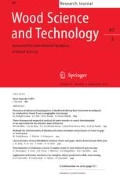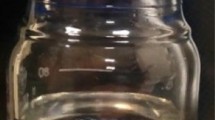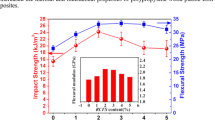Abstract
Diffuse reflectance Fourier transform infrared spectroscopy (DRIFT), solid state cross-polarization/magic-angle-spinning 13C-nuclei magnetic resonance spectroscopy (CP/MAS 13C-NMR), X-ray diffraction (XRD), thermogravimetric analysis (TGA), and thermomechanical analysis (TMA) were used in this study to elucidate the characteristics of wood sawdust after esterification. Results revealed that thermoplastic wood was produced by solvent-free esterification using octanoyl chloride. Increasing the duration of treatment enhanced the extent of esterification. After octanoylation, the crystallinity of wood sawdust was decreased, whereas thermoplasticity, hydrophobicity, and thermal stability were enhanced. The complete flow of the octanoylated wood meal was achieved at around 300°C under a force of 0.01 N, indicating that octanoylated wood sawdust is a good thermoplastic material.





Similar content being viewed by others
References
Abe Z, Oda K (1994) The color change of sugi (Cryptomeria japonica D. Don) heartwood from reddish brown to black. II. Identification of potassium hydrogen carbonate as one of the causative materials. Mokuzai Gakkaishi 40:1126–1130
Abe Z, Oda K, Matsumura J (1994) The color change of sugi (Cryptomeria japonica D. Don) heartwood from reddish brown to black. I. The color changes and its causes. Mokuzai Gakkaishi 40:1119–1125
Chang ST (1986) Quantitative color measurement of wood. Taiwan For Res Inst Bull 471:1–14
Chang ST (1997) Comparison of the green color fastness of ma bamboo (Dendrocalamus spp.) culms treated with inorganic salts. Mokuzai Gakkaishi 43:487–492
Chang ST, Wang SY, Cheng SS (2000) Environmental effects on the color of sugi (Cryptomeria japonica D. Don) heartwood. J Wood Sci 46:390–394
Engonga PE, Schneider R, Gérardin P, Loubinoux B (1999) Chemical modification of wood with perfluoroalkyl ethanol and 4,4’-diphenylmethane diisocyanate. Holzforschung 53:272–276
Fengel D, Wegener G (1989) Influence of temperature. In: Fengel D, Wegener G (eds) Wood chemistry, ultrastructure, reaction. Walter de Gruyter, Berlin, pp 319–342
Kazayawoko M, Balatineca JJ, Woodhams RT, Sodhi RNS (1998) X-ray photoelectron spectroscopy of lignocellulosic materials treated with maleated polypropylenes. J Wood Chem Technol 18:1–26
Kubo T, Ataka S (1998) Blackening of sugi (Cryptomeria japonica D. Don) heartwood in relation to metal content and moisture content. J Wood Sci 44:137–141
Kwatra HS, Caruthers JM, Tao BY (1992) Synthesis of long chain fatty acids esterified onto cellulose via the vacuum-acid chloride process. Ind Eng Chem Res 31:2647–2651
Maldas D, Kokta BV, Daneault C (1989) Influence of coupling agents and treatments on the mechanical properties of cellulose fiber-polystyrene. J Appl Polym Sci 37:751–775
Morita M, Sakata I (1986) Chemical conversion of wood to thermoplastic material. J Appl Polym Sci 31:831–840
Nakano T (1994) Mechanism of thermoplasticity for chemically-modified wood. Holzforschung 48:318–324
Raj RG, Kokta BV, Maldas D, Daneault C (1989) Use of wood fibers in thermoplastics. VII. The effect of coupling agents in polyethylene-wood fiber composites. J Appl Polym Sci 37:1089–1103
Rowell RM (1983) Chemical modification of wood. For Prod J 6:363–382
Shiraishi N (1991) Wood plasticization. In: Hon DN-S, Shiraishi N (eds) Wood and cellulosic chemistry. Marcel Dekker, New York, pp 861–906
Shiraishi N, Matsunaga T, Yokota T (1979a) Preparation of higher aliphatic acid esters of wood in an N2O4-DMF cellulose solvent medium. J Appl Polym Sci 24:2347–2359
Shiraishi N, Matsunaga T, Yokota T (1979b) Thermal softening and melting of esterified wood prepared in an N2O4-DMF cellulose solvent medium. J Appl Polym Sci 24:2361–2368
Silverstein RM, Bassler GC, Morrill TC (1991) Characteristic group absorptions of organic molecules. In: Silverstein RM, Bassler GC, Morrill TC (eds) Spectrometric identification of organic compounds, 5th ed. Wiley, New York, p 103
Simonsen J, Jacobson R, Rowell R (1998) Properties of styrene-maleic anhydride copolymers containing wood-based fillers. For Prod J 48:89–92
Takahashi K (1996) Relationships between the blacking phenomenon and norlignans of sugi (Cryptomeria japonica D. Don) heartwood. I. A case of partially black heartwood. Mokuzai Gakkaishi 42:998–1005
Takahashi K (1998) Relationships between the blacking phenomenon and norlignans of sugi (Cryptomeria japonica D. Don) heartwood. II. On blacking heartwood containing two main norlignans, sugiresinol and hydroxysugiresinol. Mokuzai Gakkaishi 44:125–133
Takase S, Shiraishi N (1989) Studies on composites and polypropylenes. J Appl Polym Sci 37:645–659
Thiebaud S, Borredon ME (1995) Solvent-free wood esterification with fatty acid chlorides. Bioresource Technol 52:169–173
Thiebaud S, Borredon ME, Baziard G, Senocq F (1997) Properties of wood esterified by fatty-acid chlorides. Bioresource Technol 59:103-107
Acknowledgments
This study was supported by a grant from the Council of Agriculture (COA). The authors wish to thank the COA for financial support and the sawmill of the experimental forest of National Taiwan University for providing sugi sawdust.
Author information
Authors and Affiliations
Corresponding author
Rights and permissions
About this article
Cite this article
Wu, JH., Hsieh, TY., Lin, HY. et al. Properties of wood plasticization with octanoyl chloride in a solvent-free system. Wood Sci Technol 37, 363–372 (2004). https://doi.org/10.1007/s00226-003-0198-0
Received:
Published:
Issue Date:
DOI: https://doi.org/10.1007/s00226-003-0198-0




